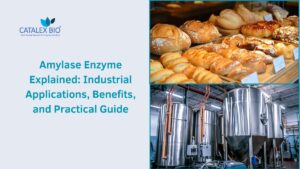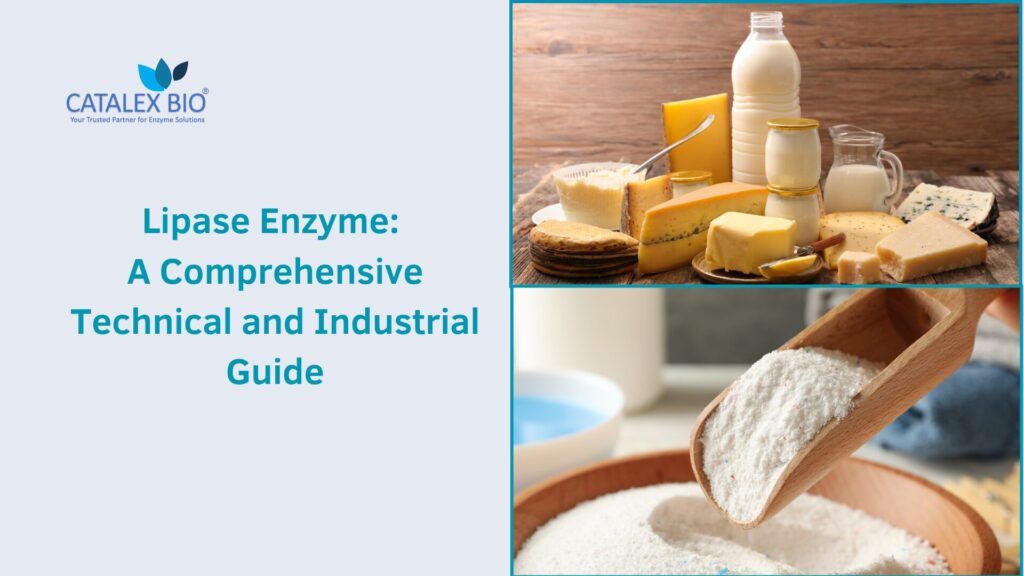1. Introduction
Enzymes are biological catalysts that have revolutionized industrial processes, replacing harsh chemicals with eco-friendly, efficient solutions. Among them, amylase stands out as one of the most commercially important enzymes worldwide.
Amylase catalyzes the hydrolysis of starch — one of the most abundant natural polymers — into smaller sugar molecules such as maltose, dextrins, and glucose. This simple yet powerful action has made amylase indispensable in industries as diverse as food and beverages, starch processing, textiles, detergents, animal feed, paper & pulp, and even pharmaceuticals.
Today, microbial amylases dominate industrial markets, owing to their low-cost production, scalability, and tunable properties through genetic engineering. Depending on the application, industries choose between fungal enzymes (preferred for acidic food systems and beverages) and bacterial enzymes (favored for thermostable, high-pH processes like starch liquefaction and detergents).
At Catalex Bio, we specialize in delivering reliable, high-performance enzyme solutions, including amylases tailored to the needs of diverse industries. We combine deep technical expertise with dependable sourcing, efficient logistics support, and comprehensive export documentation compliance — ensuring our customers achieve greater efficiency, consistency, and sustainability in their processes.
This article provides a comprehensive technical and practical guide to amylase, covering:
- History and discovery
- Structure and mechanism of action
- Sources of amylase
- Wide-ranging industrial applications
- Comparison between fungal and bacterial amylases
- Units of enzyme activity and assay methods
- Practical dosage guidelines
- User guidance for industries
- Future outlook and innovations
2. History and Discovery of Amylase
The story of amylase goes back nearly two centuries.
- 1833 — First discovery: French chemists Anselme Payen and Jean-François Persoz isolated an enzyme from malt extract that could break down starch. They called it “diastase”, derived from the Greek word for separation. This was the first enzyme ever discovered and paved the way for enzymology as a field.
- Late 1800s — Saliva and pancreatic enzymes: Scientists discovered amylase in human saliva and pancreatic secretions, explaining why starchy foods like bread or rice taste sweeter after chewing.
- Early 20th century — Industrial adoption: Brewers and bakers had long relied on malt extracts for starch breakdown, but by the early 1900s, amylase’s role in these processes was scientifically confirmed.
- Mid 20th century — Rise of microbial fermentation: With increasing industrial demand, extraction from plants and animals was no longer sustainable. Researchers turned to fungi (Aspergillus) and bacteria (Bacillus), which offered scalable enzyme production via fermentation.
- Present day — Engineered enzymes: Advances in genetic engineering, directed evolution, and immobilization techniques have led to tailor-made amylases with improved thermostability, wider pH tolerance, and enhanced efficiency.
From its humble beginnings in malt extracts to its modern role in billion-dollar industries, amylase has evolved into a cornerstone of industrial biotechnology.
3. Structure and Mechanism of Amylase Action
Amylase belongs to the glycoside hydrolase family of enzymes. It specifically targets α-1,4 and sometimes α-1,6 glycosidic bonds in starch and glycogen.
3.1 Types of Amylase
- α-Amylase
- Endo-acting enzyme: randomly cleaves internal α-1,4 bonds.
- Rapidly reduces viscosity of starch slurries.
- Produces dextrins and oligosaccharides.
- Widely used in starch liquefaction, baking, brewing.
- β-Amylase
- Exo-acting enzyme: removes maltose units from the non-reducing end.
- Common in plants, especially in germinating grains.
- Important for brewing and malting, though less common industrially.
- Glucoamylase (Amyloglucosidase)
- Hydrolyzes α-1,4 and α-1,6 linkages.
- Produces glucose as the main product.
- Mainly fungal origin, used in saccharification steps of starch processing.
3.2 Mechanism of Action
- Amylase binds to starch molecules via a substrate-binding cleft.
- Catalytic residues, typically aspartic acid (Asp) and glutamic acid (Glu), mediate hydrolysis.
- Water molecules participate in breaking glycosidic bonds.
- Products released include maltose, glucose, and dextrins, depending on enzyme type.
3.3 Factors Affecting Activity
- pH:
- Fungal amylases → optimal at pH 4.5–5.5.
- Bacterial amylases → optimal at pH 6–9, stable in alkaline conditions.
- Temperature:
- Fungal amylases → 30–55 °C.
- Thermostable bacterial amylases → up to 105 °C.
- Substrate type: Raw starch vs. gelatinized starch greatly affects hydrolysis rate.
- Metal ions: Calcium often stabilizes bacterial α-amylase. Heavy metals can act as inhibitors.
4. Sources of Amylase
Amylase is naturally found in plants, animals, and microbes, but industrial production relies almost exclusively on microbial fermentation.
4.1 Fungal Sources
- Aspergillus oryzae — Used in traditional Asian fermentations (sake, miso, soy sauce). Produces acid-stable amylase, ideal for food applications.
- Aspergillus niger — Industrial workhorse for amylase and glucoamylase production.
4.2 Bacterial Sources
- Bacillus subtilis — Produces α-amylase, moderate thermal stability.
- Bacillus licheniformis — Produces highly thermostable amylase, ideal for starch liquefaction.
- Bacillus amyloliquefaciens — Known for high enzyme yield and broad industrial application.
4.3 Plant Sources
- Found in germinating grains (barley, wheat, corn). Important in brewing and malting but rarely used industrially due to cost.
4.4 Animal Sources
- Saliva and pancreas in humans and mammals. Used diagnostically, not industrially.
4.5 Modern Biotechnology
- Recombinant DNA technology allows for engineered amylases with tailored properties.
Immobilized enzymes enable reuse in continuous processes, reducing costs and improving sustainability.
5. Industrial Applications of Amylase
Amylase is among the top three enzymes sold globally. Its versatility makes it indispensable in many industries.
- Liquefaction: Bacterial α-amylase (thermostable) reduces viscosity of starch slurries at high temperatures.
- Saccharification: Fungal glucoamylase converts dextrins into glucose.
- Products: Glucose syrup, maltose syrup, high-fructose corn syrup (HFCS).
- Benefits: Continuous processing, reduced energy demand, higher yields.
5.2 Baking Industry
- Fungal α-amylase hydrolyzes starch into sugars, enhancing yeast fermentation.
- Improves bread volume, texture, and crumb softness.
- Maltogenic amylases reduce bread staling, extending shelf life by several days.
- Converts cereal starches into fermentable sugars.
- Bacterial amylases aid liquefaction; fungal amylases perform saccharification.
- Increases alcohol yield, reduces viscosity, and improves filtration.
- Bacterial amylases are stable in alkaline pH (9–11) and washing temperatures.
- Break down starchy stains such as pasta, rice, and sauces.
- Combined with proteases and lipases in modern enzyme-based detergents.
5.5 Textile Industry
- Desizing agent: Removes starch-based sizing agents applied to fabrics before weaving.
- Replaces harsh chemicals, reducing environmental impact.
- Fungal amylases for gentle desizing; bacterial amylases for high-temperature processes.
- Reduces viscosity of starch used in paper coatings.
- Improves paper strength, smoothness, and print quality.
- Enhances starch digestibility in poultry, swine, and aquaculture feeds.
- Fungal enzymes → effective in acidic gut.
- Bacterial enzymes → withstand high temperatures during feed pelleting.
5.8 Juice and Wine Clarification
- Fungal amylase reduces haze caused by starch residues.
- Improves clarity, filterability, and stability of juices and wines.
5.9 Clinical Applications
- Amylase assays are used in medical diagnostics, particularly for detecting pancreatitis and related disorders.
6. Fungal vs. Bacterial Amylase: Detailed Comparison
| Parameter | Fungal Amylase | Bacterial Amylase |
| Source | Aspergillus oryzae, A. niger | Bacillus subtilis, B. licheniformis |
| Optimal pH | 4.5–5.5 (acidic) | 6.0–9.0 (neutral to alkaline) |
| Temperature Range | 30–55 °C | 50–105 °C |
| Applications | Baking, beverages, mild textiles, animal feed | Starch liquefaction, detergents, brewing, pulp & paper |
| Advantages | Works in acidic conditions, enhances bread softness | Thermostable, alkaline-stable, fast viscosity reduction |
| Limitations | Poor stability at high temp/pH | Not suitable for acidic processes |
Rule of thumb:
- Use fungal amylase in food and beverage industries.
- Use bacterial amylase in high-temperature, industrial processes.
7. Units of Amylase Activity Measurement
Different units are used across industries:
- IU (International Unit): 1 µmol reducing sugar released/min.
- DU (Dextrinizing Unit): Based on rate of dextrinization.
- SKB Unit: Common in baking and brewing.
- FAU (Fungal Amylase Unit): Used for fungal enzyme specs.
- BAU (Bacterial Amylase Unit): Used for bacterial enzyme specs.
- KNU (Kilo Novo Unit): Used in starch industry.
8. How Amylase Activity is Measured (Assay Methods)
1. DNS (3,5-Dinitrosalicylic Acid) Method
- Measures release of reducing sugars.
- Sensitive, versatile, widely used in labs and food industries.
2. Iodine-Starch Complex Test
- Starch turns blue with iodine; as amylase hydrolyzes starch, the color fades.
- Simple and common in brewing/baking.
3. Ceralpha Method
- Uses a synthetic substrate linked to a chromophore.
- High precision, widely used in detergent and textile enzyme testing.
4. Viscosity Reduction Method
- Measures decrease in viscosity of starch slurries.
- Matches real-world needs in starch and pulp industries.
5. Commercial Kits
- Ready-to-use kits for food, feed, and brewing labs.
- Convenient but more costly.
Note: Always check which assay your supplier uses — different assays yield different activity units.
9. Dosage Guidelines for Different Industries
| Industry | Enzyme Source | Typical Dosage | Notes |
| Baking | Fungal | 20–100 FAU/kg flour | Improves yeast activity, bread texture |
| Starch Processing | Bacterial | 0.1–0.6 kg/ton starch | Thermostable liquefaction |
| Brewing | Bacterial + Fungal | 0.1–0.3 kg/ton (bacterial), 0.05–0.15 kg/ton (fungal) | Liquefaction + saccharification |
| Detergents | Bacterial | 0.1–0.5% in formulation | Stable in alkaline wash |
| Textiles | Fungal/Bacterial | 0.5–2.0 g/L bath | Mild vs. high-temp desizing |
| Paper & Pulp | Bacterial | 0.02–0.1% starch | Viscosity control |
| Juice/Wine | Fungal | 50–200 FAU/1000 L | Clarification |
| Animal Feed | Fungal/Bacterial | 200–800 FAU/kg feed | Improves starch digestibility |
10. Practical Guidance for Enzyme Users
- Choose the right source: fungal for food/beverages; bacterial for industrial, thermostable needs.
- Confirm activity units: avoid confusion between IU, FAU, KNU, etc.
- Run pilot trials: enzyme efficiency depends on process conditions.
- Optimize blends: amylase works well with proteases, lipases, xylanases.
- Store correctly: below 25 °C, dry conditions; expect <10% annual activity loss.
- Safety: avoid dust inhalation, use protective equipment for powders.
11. Future Outlook and Innovations
The future of amylase is shaped by sustainability and biotechnology.
- Genetic engineering: Development of amylases with improved thermostability, broader pH range, and higher efficiency.
- Biofuels: Starch hydrolysis in ethanol production is expanding.
- Plant-based foods: Amylases enhance starch digestibility in plant proteins and alternative meats.
- Green textiles: Enzyme-based desizing will continue to replace harsh chemicals.
- Immobilization: Amylases immobilized on carriers can be reused in continuous processes, reducing costs.
12. Conclusion
Amylase is a cornerstone biocatalyst with unmatched versatility across industries. Its ability to efficiently hydrolyze starch has made it essential in food, beverage, detergent, textile, pulp & paper, feed, and even medical applications.
Choosing between fungal and bacterial amylase depends on the process environment: fungal for acidic/mild conditions, bacterial for thermostable/alkaline operations. Understanding assay methods, activity units, and dosage guidelines is critical for optimal results.
As biotechnology advances, engineered amylases will play an even larger role in sustainable, green industrial processes, supporting the global shift toward efficiency and eco-friendliness.
At Catalex Bio, we are committed to supporting industries with scientifically validated enzyme products, expert guidance, and reliable solutions. Whether you’re optimizing baking, brewing, detergents, or industrial starch processing, our amylase enzyme solutions are designed to deliver performance and consistency you can trust.
Get in touch with Catalex Bio today to explore our amylase enzyme portfolio or discuss how we can support your specific process requirements.




Pingback: The Evolution of Enzymes in Food Technology | Past, Present & Future | Catalex Bio
Pingback: How Enzymes Replace Harsh Chemicals in Industry | Catalex Bio